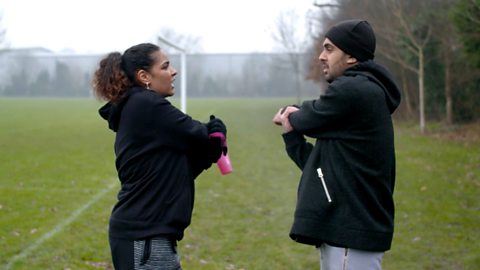Reading in detail and responding
Watch the video to find out more.
Speaker 1: Hey, I’ve found a possible job as a stockroom assistant.
Speaker 2: That’s great! How do you apply?
Speaker 1: Well, I have to read the job spec in detail to find out.
OK, here’s the description of the company.
And this is a bit about pay and benefits. Nice to know, but it’s not about applying for the job.
Speaker 2: I usually check if I’m qualified to apply before I go any further.
What are they looking for?
Speaker 1: Good point, I’ll just scan through it for the key info.
Qualifications needed, yep, got that. Experience, 12 months in a stockroom or warehouse, got that too.
Speaker 2: Brill! What next? What do you have to do to apply?
Speaker 1: 'How to apply.' In bold.
Speaker 2: Your CV and a personal statement of 300 words.
Speaker 1: And they want it emailed with the subject line, 'Stockroom Assistant'. And when do they want it?
Speaker 2: There, deadline.
Speaker 1: Friday the 13th. Still, I’ve got a good feeling about this one.
I’m going to go home to read over the rest of it and sort out my CV.
Speaker 2: Good luck.
Spot the job titles
Test your knowledge with this activity.
Evaluating a text and making choices
Watch the video to find out more.
Speaker 1: (TO AUDIENCE) When we read we need to evaluate what we’re reading.
What options and solutions does the text give us?
Is any language unclear? We’re currently browsing this college website.
It gives us information divided up into categories with drop-down menus.
Like course information and subheadings like IT and business.
Speaker 2: (TO OTHER PEOPLE) It says the 'IT skills for the workplace' course is 40 hours and no previous IT qualification is needed.
Speaker 1: (TO AUDIENCE) It’s good to look at the options and choices.
But it’s also good to think about where you need more information.
Speaker 3: (TO OTHER PEOPLE) There are some business courses as well.
Speaker 2: Oh yeah, and you end up with different qualifications.
I’ll have to check if they need prior knowledge or skills.
Speaker 1: (TO AUDIENCE) So, by evaluating what she’s reading, Tina knows she’s got a few things to consider.
What subject to study, how many hours each subject takes.
What skills or qualifications are required, and what she’ll learn.
Match the heading to the notes
Test your knowledge with this activity.
Reading and responding
Watch the video to find out more.
Speaker 1: This isn’t right. No potatoes and hundreds of cauliflowers!
Speaker 2: (TO AUDIENCE) Reading carefully and looking for the most useful information can help you to respond in a really effective way and find solutions to problems.
(TO OTHER PEOPLE) Let's look at the information on the delivery order.
(TO AUDIENCE) Start by identifying the information you need.
(TO OTHER PEOPLE) So you’ve got here one box of caulis and ten bottles of olive oil.
Speaker 1: 'Reporting errors in your delivery' – I'll call them.
Speaker 2: It says you need your order number and client reference.
Speaker 1: Thanks. So I'll ask them to come and collect the cauliflower and when they do, to bring me the ten bottles of olive oil I need.
I'll add in an extra potato order and I want the difference refunded.
Speaker 2: (TO AUDIENCE) So, once you've found the right details, it’s really important to have a plan of action, otherwise you just won't get the results you need.
Speaker 1: (TO OTHER PEOPLE) Great, thanks. I’ll see you soon.
Olive oil, potatoes and refund coming in the next three hours… and I get to keep the cauliflower. Cauliflower curry for lunch?
Can you fix a problem with a delivery?
Test your knowledge with this activity.
More on Learn the basics
Find out more by working through a topic
- count7 of 10

- count8 of 10
